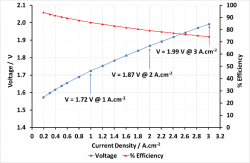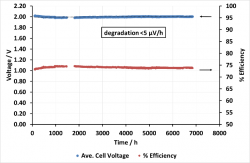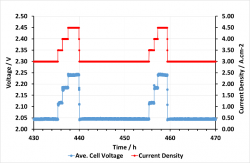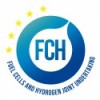Technical Highlight
Published: August 17
Increase in Hydrogen Production Rate
ITM Power increases hydrogen production rate of its PEM Water Electrolyser three-fold observing negligible impact on degradation during laboratory stack testing
Introduction
The large-scale deployment of wind power and solar energy sources will strongly contribute to the implementation of Europe’s energy policies objectives i.e. to produce 65% of electricity from renewable energy sources by 2050 and to reduce CO2 emissions linked to energy production by 50%.1
However, wind power and solar energy resources are characterised by intermittent behaviour and their fluctuations affect the stability and reliability of the electrical grid. Consequently, there is a strong need for rapid-response, cost-effective and scalable energy storage systems capable of absorbing the electrical power exceeding the capacity of a transport and distribution line.
Hydrogen produced from water electrolysis can play a significant role as an energy storage medium.1,2 Electrolysis can support the electricity grid in terms of power quality, frequency and voltage control, peak shaving, load shifting and demand response. However, current electrolysers, especially those based on alkaline systems, are characterised by poor dynamic behaviour.
Future electrolysers need to be highly efficient across a wide load curve, capable of handling frequent start-stops and be able to follow the variable energy generation profiles of locally available renewable power sources, to provide superior grid-balancing services, to address the steep increase of intermittent renewables interfacing with the grid.
Recent ITM Power R&D
In working towards this goal ITM Power have been conducting tests in the laboratory on their commercial Proton Exchange Membrane (PEM) water electrolyser stack at significantly higher current densities than their nominal operating point of 1 – 1.5 A.cm-2 (Figure 1).

Figure 1 Voltage and efficiency measured at 15 bar, 53 – 55 °C
Stacks, generating hydrogen at 15 – 20 bar, were operated at 3 A.cm-2 for over 6,000 h and up to 4.5 A.cm-2 for short periods of time, with minimal impact on the stack’s degradation. In one test, a stack operating continuously for 6865 h at 3 A.cm-2, generating hydrogen at a pressure of 15 bar, had a measured voltage degradation of <5 µV/h, equating to an efficiency loss of <2 %/year (8000 h) (Figure 2).

Figure 2 Measured average cell voltage and efficiency of a 3-cell stack operating at 15 bar, 54 °C
In another test, a stack operating at 3 A.cm-2, generating hydrogen at a pressure of 20 bar and intermittently operated at up to 4.5 A.cm-2, showed a similarly low level of degradation (Figure 3).

As the electrolyser’s hydrogen production rate is directly related to the operating current density, according to Faraday’s law, a three-fold increase in current density from the present 1 – 1.5 A.cm-2 to 3 – 4.5 A.cm-2, with a modest efficiency penalty, will proportionally reduce stack costs by a factor of three, helping to reduce the capital cost of the overall system.
Context
This work is taking place as part of the FCH-JU funded HPEM2GAS project, which has the ambition of realising breakthroughs in PEM water electrolysis technology for cost-effective grid balancing applications. The aim of the project is to develop a 180 kW highly efficient, flexible and durable water electrolysis system, which will then be shipped to Emden and interfaced with the city’s electricity and gas grid for a 6-month field test. R&D in innovative hydrogen production from grid-service and renewable energy sources (Power to Gas) is one of the priorities of the FCH-JU Multi Annual Work Plan as it can bring about a zero carbon hydrogen economy.
References
- Bertuccioli, L ., Chan, A., Hart D., Lehner F., Madden, B., Standen, E., Development of Water Electrolysis in the European Union. FCH JU, Brussels (2014). http://www.fch-ju.eu/sites/default/files/study%20electrolyser_0-Logos_0.pdf
- Genovese, J., et al. Current State-of-the-Art Hydrogen Production Cost Estimate Using Water Electrolysis Independent Review, Published for the U.S. Department of Energy Hydrogen Program. National Renewable Energy Laboratory 1617 Cole Boulevard, Golden, Colorado (2012).
ITM Power Head Office
22 Atlas Way
Sheffield
S4 7QQ
ITM Power Plc is a public limited company in England and Wales
Company Number: 0509407
© 2017 ITM Power Plc
![]()




